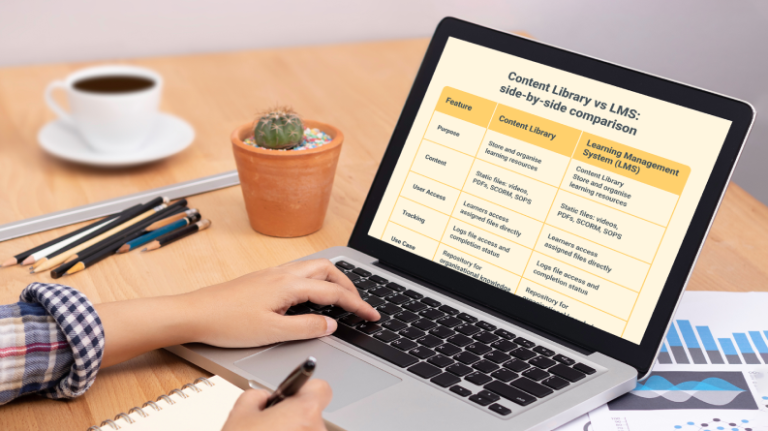Implementing a Learning Management System (LMS) can be a complex process, but with careful planning and execution, you can ensure a successful launch. In this article, we’ll explore how to launch LMS successfully.
What can go wrong during an LMS implementation?
During an LMS implementation, several challenges and issues can arise that may hinder the success of the project. Being aware of potential pitfalls can help you mitigate risks and plan accordingly. Here are some common issues that can occur during an LMS implementation:
- Insufficient planning: Inadequate planning can lead to delays, budget overruns, and a lack of clarity in project goals. Without a well-defined implementation plan, you may encounter difficulties in resource allocation, task management, and coordination among team members.
- Poor stakeholder involvement: If key stakeholders are not actively engaged in the implementation process, it can result in misalignment of goals, lack of support, and resistance from employees. It is crucial to involve stakeholders from different departments and levels of the organisation to ensure their needs and concerns are addressed.
- Inadequate training and support: Insufficient training for administrators, content creators, and end-users can hinder the adoption and utilisation of the LMS. Without proper guidance and support, users may struggle to navigate the system, leading to frustration and low engagement.
- Data migration challenges: Migrating existing data, such as user profiles, course content, and completion records, from legacy systems to the new LMS can be complex. Data integrity issues, formatting inconsistencies, and compatibility problems may arise during the migration process, potentially impacting the accuracy and completeness of the data.
- Integration issues: Integrating the LMS with other systems, such as HRIS, CRM, or SSO solutions, can present technical challenges. Incompatibility between systems, data synchronisation problems, or security issues may arise, requiring careful coordination with the IT team and thorough testing.
- Content management difficulties: Organising and uploading content into the LMS can be time-consuming, especially if you have a large volume of existing content. Inconsistent content formatting, version control issues, and limited content authoring capabilities within the LMS can pose challenges to content management.
- User resistance and adoption challenges: Employees may resist using the new LMS due to various reasons, such as a lack of awareness, scepticism, or a preference for traditional training methods.
Steps to implement an LMS in your business
Implementing a Learning Management System (LMS) in your business can be a transformative step towards effective training and development. Here are the steps to follow for a successful LMS implementation:
- Identify training needs
- Set training goals
- Set success criteria
- Create an LMS implementation plan
- Pick your implementation team and assign roles
- Identify necessary training content
- Set up your LMS
- Trial your new LMS
- Asses test results
- Refine your LMS
- Launch your LMS
- Motivate users to engage with the LMS and its content
- Encourage users to report issues
LMS implementation tips and tricks
Thoroughly assess your needs and select the right LMS: Before implementing an LMS, conduct a comprehensive needs assessment to understand your organisation’s requirements. Consider factors such as the number of users, content types, desired features, and integration capabilities. This will help you choose an LMS that aligns with your needs and maximises the chances of a successful implementation.
Involve key stakeholders from the beginning: Engaging key stakeholders, such as L&D professionals, IT personnel, and end-users, early in the implementation process is vital. Their input and feedback will help ensure that the LMS meets organisational goals and user requirements. By involving stakeholders from the start, you can build support, address concerns, and create a sense of ownership, increasing the chances of a smooth implementation and successful adoption.
- Update content: Updating content regularly is an essential LMS implementation tip to ensure ongoing engagement and relevance. By regularly updating content within the LMS, you can keep learners engaged and provide them with up-to-date information and resources. Develop a content update plan that outlines timelines and responsibilities for content review, revision, and addition. Encourage subject matter experts to regularly assess and update existing materials and incorporate new content that aligns with the evolving needs of your learners. By prioritising content updates, you can enhance the learning journey, address emerging topics, and ensure that the LMS remains a valuable resource for continuous learning and development.
- Add new content regularly: Adding new content regularly is a valuable tip for LMS implementation to keep the learning experience fresh and engaging. Continuously adding new content ensures that learners have access to a diverse range of resources and opportunities for growth. Develop a content creation plan that outlines the process for generating new materials, including collaboration with subject matter experts, content review, and quality assurance. Encourage content creators to explore different formats such as videos, interactive modules, or microlearning to cater to various learning preferences. By regularly adding new content, you can foster a culture of continuous learning and provide learners with relevant and timely information, enhancing the overall effectiveness of your LMS.
- Listen to the user feedback: Listening to user feedback is a crucial tip for LMS implementation to ensure user satisfaction and continuously improve the learning process. Actively seek feedback from learners, administrators, and other stakeholders through surveys, focus groups, or feedback mechanisms within the LMS. Pay attention to their suggestions, concerns, and pain points to gain insights into areas that require improvement. Analyse the feedback received and use it to refine the LMS interface, navigation, content, or features based on user needs and preferences. By incorporating user feedback, you demonstrate a commitment to meeting their expectations, fostering user engagement, and continuously enhancing the LMS to better serve their learning goals.
- Motivate employees’ managers to encourage others and participate: Motivating employees‘ managers to encourage others and actively participate in the LMS is a valuable tip for successful implementation. Managers play a crucial role in driving engagement and adoption of the LMS among their teams. To achieve this, provide managers with clear information about the benefits of the LMS and how it supports their teams’ development. Offer training sessions specifically designed for managers to help them understand the LMS’s features and how to support their employees in utilising it effectively. Encourage managers to lead by example by actively participating in the LMS, completing courses, and providing feedback. By fostering a supportive environment where managers champion the LMS, you can create a culture of learning and increase employee motivation and engagement with the platform.
Would you like to empower your employees for free?
Alison’s free learning management system (LMS) is unlike other e-learning platforms. It has over 4000+ courses across a wide range of subjects and industries that you can register for. Here, businesses, schools, and philanthropic organisation can design customised learning paths based on their unique business and personnel needs.
- Unlimited number of team members
- Quick and easy set-up time and process
- Aggregate and individual reporting: set up your group’s training progress with a choice of daily, weekly, or monthly reports, you can keep track of the academic progress your team makes.
Remember that successful LMS implementation is an iterative process. Continuously gather feedback, listen to user needs, and adapt the system accordingly to ensure it remains aligned with your organization’s evolving training requirements.









